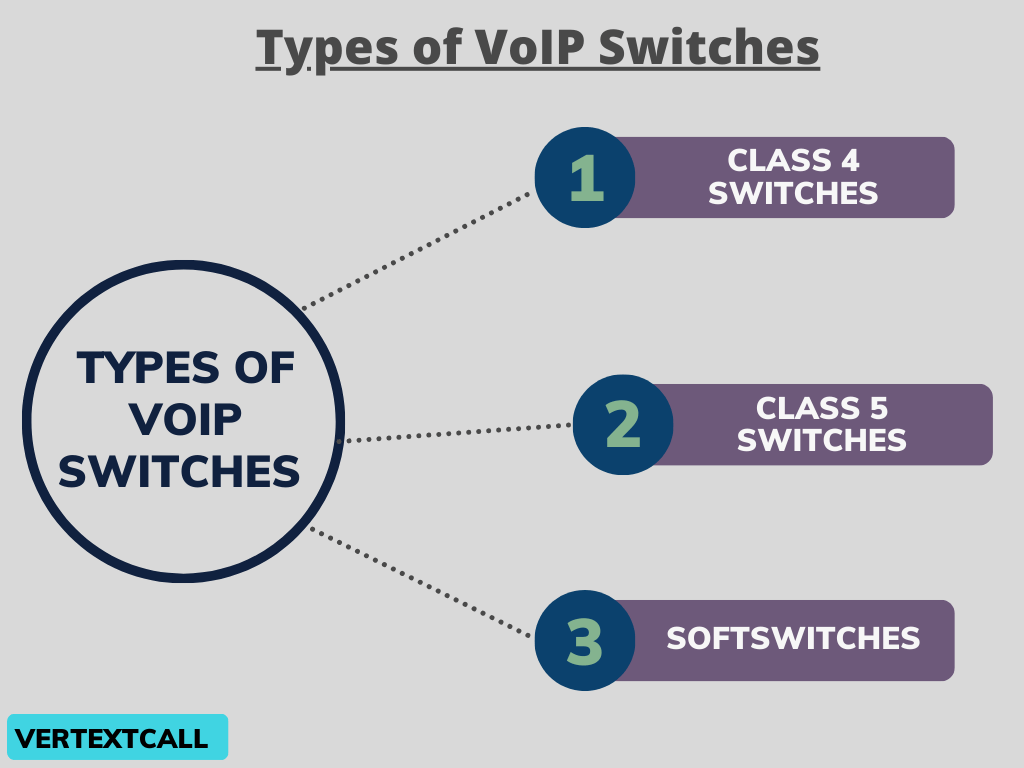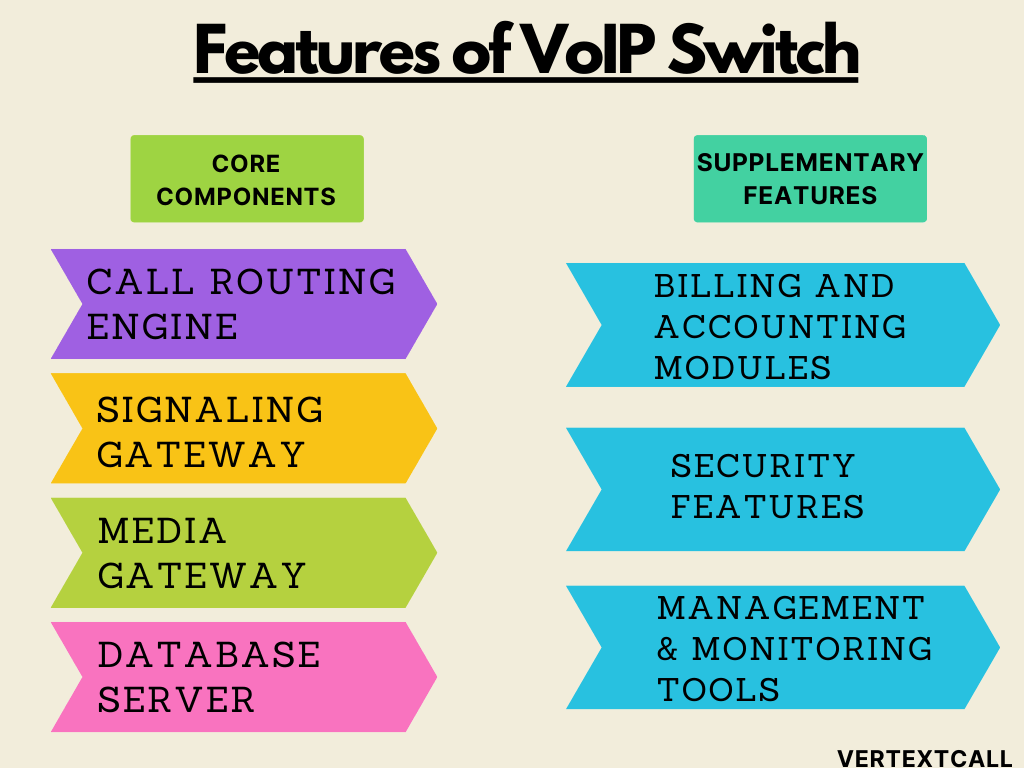A crucial component of this VoIP system is the VoIP switch, which ensures that voice data is properly transmitted over your network.
This blog explores VoIP switches in detail including various well-known models like the Cisco Catalyst 2960, Netgear ProSAFE GS728TP, and HP Aruba 2530.
We will also discuss key factors to consider when choosing a VoIP switch, setting it up, and maintaining it for peak performance. By understanding these aspects, you can make informed decisions to optimize your business communication infrastructure.
What is a VoIP switch?
A VoIP switch is an integral part of voice communications over the Internet. It serves as a central component within a VoIP network, supporting the routing of voice calls between various endpoints.
Essentially, the VoIP switch manages the setup, conduct, and termination of calls, ensuring efficient communication.
By converting voice signals into digital data packets, it uses internet protocols to transmit calls over the internet, thereby reducing the cost and complexity associated with traditional phone systems.
How does a VoIP switch work?
A VoIP switch operates by performing several key functions to enable effective voice communication over an Internet Protocol (IP) network.
Call Setup Process
The call setup process in a VoIP system involves several detailed steps:
- Dialing: When a user dials a number, the VoIP switch receives the call request.
- Signaling: The switch initiates signaling protocols (such as SIP or H.323) to establish a connection between the caller and the recipient.
- Connection Setup: The switch arranges codec agreements and other parameters to optimize the call quality.
- Call Establishment: Once the connection parameters are set, the call is established, allowing real-time voice communication.
Signal Conversion
One of the primary functions of a VoIP switch is to convert analog voice signals into digital packets:
- Analog-to-Digital Conversion: The switch uses an analog-to-digital converter (ADC) to transform voice signals into digital data.
- Codec Negotiation: The switch handles codec coordination to ensure compatibility among various devices. Common codecs include G.711, G.729, and Opus.
Routing and Switching
Routing and switching are essential for determining the optimal path for voice data:
- Call Path Determination: The switch evaluates various routing options to select the most efficient path for the call.
- Quality of Service (QoS): The switch effectively manages Quality of Service (QoS) settings, ensuring that voice traffic is given priority to maintain superior call quality, even when the network experiences high levels of congestion.
Differences between VoIP switch and SIP switch
Aspects | VoIP Switch | SIP Switch |
Primary Function | Routes and switches voice calls over IP networks. | Specifically handles SIP signaling and routing for initiating, maintaining, and terminating calls. |
Analog-to-Digital Conversion | Converts analog voice signals into digital packets for transmission over IP networks. | Focuses on SIP signaling; and typically relies on other components for analog-to-digital conversion. |
Compatibility | Integrates with multiple types of VoIP devices and systems encompassing a range of protocols. | Works mainly within SIP-based systems and devices, ensuring optimal communication within SIP ecosystems. |
Call Management | Manages call setup, conduct, and termination through comprehensive signaling and session management. | Manages call setup and termination |
Quality of Service (QoS) | Implements QoS settings to prioritize voice traffic, ensuring minimal latency and high-quality calls. | Utilizes SIP-specific QoS mechanisms to manage call quality within SIP sessions. |
Types of VoIP switches

1/ Class 4 Switches:
Class 4 switches are a type of VoIP switch designed primarily for handling the routing of long-distance and inter-office calls. They form the core of the VoIP infrastructure, connecting different nodes in a wide area network (WAN).
The main functions of Class 4 switches include efficient call routing, load balancing, and managing call transfer between other Class 4 or Class 5 switches.
These switches are capable of managing high volumes of voice traffic, ensuring that your call setup is uninterrupted even over long distances.
They also incorporate advanced features such as automatic call distribution and fault tolerance to maintain call quality and reliability.
By strategically routing long-distance calls, Class 4 switches help you reduce operational costs and improve the efficiency of VoIP networks.
2/ Class 5 Switches:
Class 5 switches are another crucial type of VoIP switch, mainly responsible for managing local and end-user VoIP service delivery.
Unlike Class 4 switches, which handle long-distance and inter-office communications, Class 5 switches are designed to work at the subscriber level.
They address individual users or small business VoIP services, enabling connection, disconnection, and the management of telecommunication features.
The primary functions of Class 5 switches include call routing within local exchanges, providing dial-tone services, and supporting various user-centric services such as voicemail, caller ID, call forwarding, and conferencing.
3/ Softswitches:
Softswitches, also known as software switches, serve as central hubs for VoIP communications by controlling and directing voice traffic across your data network.
Unlike traditional hardware-based switches, Softswitches operate on your general-purpose servers, utilizing software to perform switching functions.
They provide a flexible, scalable solution that supports various VoIP protocols and services. Key functionalities include call routing, signaling control, and the management of multimedia sessions, allowing you to handle voice, video, and data integration easily.
Key features of VoIP switch

Core Components
1/ Call Routing Engine:
The call routing engine is a fundamental component within a VoIP switch, responsible for determining the most efficient path for voice data packets to travel from the caller to the recipient.
This engine analyzes various routing criteria such as least cost routing, quality of service (QoS) parameters, and network topology to make decisions quickly.
2/ Signaling Gateway:
The signaling gateway operates as a link between different signaling protocols used in telecommunications networks.
It translates signaling information from traditional PSTN (Public Switched Telephone Network) protocols such as SS7 (Signaling System No. 7) to IP-based protocols like SIP (Session Initiation Protocol).
This conversion ensures that telephony systems and modern VoIP networks can work together and connect with ease.
Related Reading:
3/ Media Gateway:
The media gateway is an essential part of a VoIP switch that converts voice data between different formats. It changes voice data from traditional phone systems (like the PSTN) into packets that can travel over the internet and vice versa.
This gateway ensures that voice conversations can move efficiently between old phone networks and new IP-based networks, making sure the audio quality is good.
4/ Database Server:
The database handles the storage and management of all essential data used in call processing and routing. It maintains information such as user accounts, call records, and routing tables.
This server ensures that up-to-date data is easily available for the VoIP switch to function efficiently. By organizing and providing access to this information, the database server supports the fast and accurate handling of voice calls, contributing to the overall reliability and performance of the VoIP network.
Supplementary Features
4/ Billing and Accounting Modules:
These modules track the usage of VoIP services and calculate the costs associated with those services. They ensure that users are billed correctly based on their call patterns and usage.
The modules store detailed records of every call, including the duration and destination, and generate reports for billing purposes.
Related Reading: Types of VoIP services
5/ Security Features (firewalls, encryption):
Security features in a VoIP switch are designed to protect the network and the data it handles. These features include encryption, which hides voice data during transmission so that unauthorized parties cannot access it.
They also include user authentication mechanisms to validate user identities, ensuring that only authorized individuals have access to the system and the ability to initiate calls.
Additionally, firewalls are implemented to block harmful traffic and prevent cyber attacks. By implementing these security measures, a VoIP switch helps to maintain the privacy of all communications within the network.
6/ Management and Monitoring Tools:
Management and monitoring tools in a VoIP switch are used to oversee the performance of the network and ensure its smooth operation.
These tools offer instant insights into system efficiency, call quality, and network traffic. They allow administrators to track, analyze, and resolve issues quickly, ensuring VoIP services run efficiently.
What are the best switches for VoIP networks?
Choosing the right switch for your VoIP network depends on various factors, including business size, communication needs, and budget. Here are some top recommendations:
1/ Cisco Catalyst 2960 Series:
The Cisco Catalyst 2960 series supports PoE, allowing the simultaneous transmission of electrical power and data through a single Ethernet cable. QoS capabilities ensure optimal call quality by prioritizing voice traffic.
2/ Netgear ProSAFE GS728TP:
The Netgear ProSAFE GS728TP switch is ideal for small to medium-sized businesses. It offers PoE+ support, providing sufficient power for advanced VoIP phones. The switch also includes VLAN capabilities, which enable streamlined network segmentation and management.
3/ HP Aruba 2530 Series:
The HP Aruba 2530 series is another choice for VoIP networks. It delivers reliable performance, PoE support, and advanced management features such as traffic prioritization, VLAN support, and integration with network management tools. With its user-friendly interface, it simplifies the setup and maintenance of VoIP networks.
Implementing VoIP switch
Choosing the Right VoIP switch
When selecting a VoIP switch, consider the following factors:
1/ Business Size:
Understanding the scale of your business is essential when selecting a VoIP switch. Larger enterprises with high call volumes and extensive network requirements will benefit from a more scalable VoIP switch that can handle greater traffic and offer advanced features.
On the other hand, small to medium-sized businesses might prioritize cost-effectiveness and ease of implementation.
Therefore, it is essential to match the VoIP switch capabilities with your business scale to ensure efficient and reliable communication.
2/ Required Features:
It is essential to identify the specific features your business needs in a VoIP switch to assure optimal performance and functionality.
For example, if your business prioritizes advanced call management capabilities such as call forwarding, conference calling, and voicemail services, you should select a VoIP switch that includes these features.
Additionally, consider if features such as automated attendants, integration with other business applications, and strong security measures are important for your operations.
Integration with Existing Systems
Compatibility with your current network infrastructure and other VoIP components is crucial:
1/ Network Infrastructure:
Verify that the VoIP switch is compatible with your existing network setup, including routers, firewalls, and internet connections.
2/ VoIP Components:
Ensure that the VoIP switch can integrate with your existing VoIP components. This includes compatibility with your VoIP phones, gateways, and any other telephony hardware or software you are currently using.
The switch must support the protocols and codecs that your devices use to avoid any compatibility issues that could affect the quality and reliability of your VoIP communications.
Related Reading: Types of IP phones
Configuration and Setup
Proper configuration and setup are vital for optimal performance:
1/ Initial Setup Process:
Properly configuring a VoIP switch from the outset is critical for optimal performance. This involves connecting the switch to the existing network and configuring it according to your business’s specific requirements.
Ensure that all network settings are correctly applied and that the switch can handle your call volume and data traffic.
This step is crucial as it impacts the overall efficiency and reliability of your VoIP system. By doing so, you can ensure that your communications remain clear, secure, and uninterrupted.
2/ Configuration Options:
Setting up the VoIP switch correctly is also necessary to ensure that it works well for your business. The initial setup process involves connecting the switch to your network and configuring it to meet your specific needs.
Key steps include configuring IP addresses, VLANs (Virtual Local Area Networks), and QoS (Quality of Service) settings. This ensures the switch can handle the volume of calls and data traffic, maintaining clear and reliable communication.
3/ Ongoing Maintenance and Support:
Consistent maintenance and support are essential to keep your VoIP switch performing at its best:
- Updates and Patches: Ensure your switch maintains optimal security and performance by regularly updating its software with the latest patches and updates.
- Monitoring: Use monitoring tools like the Call Quality Dashboard (CQD) and VoIP monitor to track performance metrics, detect potential issues, and optimize call quality.
- Technical Support: Have access to reliable technical support for troubleshooting and resolving issues promptly, such as assisting with software installation or fixing connectivity problems.
Frequently Asked Questions
Q1) Do I need a special switch for VoIP?
Ans: Yes, you need a switch that supports VoIP protocols and is capable of handling the unique requirements of VoIP traffic. A VoIP-compatible switch is designed to prioritize voice traffic and manage Quality of Service (QoS) settings, ensuring clear and reliable communication.
Q2) What is the best switch for VoIP?
Ans: The best switch for VoIP is the Cisco Catalyst 2960-X Series. This switch offers advanced Quality of Service (QoS) mechanisms to prioritize voice traffic. Additionally, it supports power over Ethernet (PoE) to simplify the deployment of VoIP phones and other devices.
Q3) Can a VoIP phone be connected to a switch?
Ans: Yes, a VoIP phone can be connected to a switch. The switch must be VoIP-compatible, supporting the necessary protocols and features to handle voice traffic effectively. Typically, the switch should have Power over Ethernet (PoE) features to supply electricity to the VoIP phones through the network cable. This setup removes the need for individual power adapters, simplifying installation.
Q4) Do VoIP phones need a PoE switch?
Ans: No VoIP phones do not necessarily need a PoE switch as VoIP phones can function with a standard network switch.
Q5) Does VoIP use circuit switching?
Ans: No, VoIP does not use circuit switching; it uses packet switching. Circuit switching involves establishing a fixed communication path between two parties for the entire duration of a call, a method traditionally used by telephone networks.
Q6) What is the Sippy switch in a VoIP dialer?
Ans: The Sippy switch is a specialized software-based VoIP switch used in VoIP dialers and telephony systems. It operates as a session border controller (SBC) and provides essential functionalities for managing and routing voice-over IP traffic.

